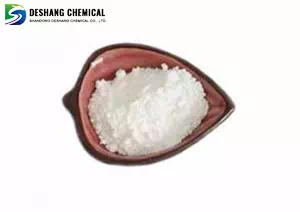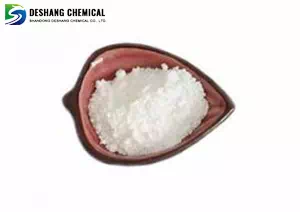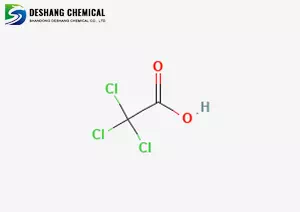All Categories



Trichloroacetic acid CAS 76-03-9, Trichloroacetic, acid CAS 76-03-9
Trichloroacetic acid CAS 76-03-9 decomposes into chloroform and carbonate when exposed to strong alkali. Toxic gases such as hydrogen chloride and carbon monoxide are released at high temperatures.
CAS : 76-03-9
Formula : C2HCl3O2
Mol. wt. : 163.39
EINECS : 200-927-2
| CAS | 76-03-9 |
| Molecular formula | C2HCl3O2 |
| Molecular weight | 163.39 |
| EIENCS | 200-927-2 |
| Form | Solid |
| Melting point | 54-58 °C |
| boling point | 196 °C |
| Density | 1.62 g/mL at 25 °C |
| Solubility | H2O: 0.5 M at 20 °C, clear, colorless |
| PKA | 0.7(at 25℃) |
| Color | White |
| Storage temp | Store at +15°C to +25°C. |
Molecular formula and structure
Molecular formula: C₂HCl₃O₂
Molecular weight: 163.39 g/mol
Structure: In the acetic acid molecule, the three hydrogen atoms of the methyl group are replaced by chlorine (Cl₃, CCOOH), making it a strong organic acid.
Appearance: Colorless to white crystals, hygroscopic, with a pungent odor.
It decomposes into chloroform and carbonate when exposed to strong alkali. Toxic gases such as hydrogen chloride and carbon monoxide are released at high temperatures.
Dilute solutions (<30%) are prone to decomposition and should be prepared and used immediately.
1.Biochemistry and Medicine (accounting for 45%)
Protein precipitant
The precipitation of proteins through acid denaturation and exposure of hydrophobic groups is used to extract biochemical drugs such as ATP and cytochrome C.
Note: Macromolecular proteins (>100 kDa) may produce fragments due to acid hydrolysis, and the residues should be thoroughly washed off with acetone.
Pharmaceutical application
Dermatological wart remover (concentration 80-90%), astringent and hemostatic; Sodium trichloroacetate is a selective herbicide.
2. Agriculture and Industry (accounting for 35%
Pesticide intermediates: Key raw materials for the synthesis of the insecticide chlorpyrifos and the herbicide sulfoxpiazole.
Industrial Solvents and Synthesis
Introducing chlorine atoms in dye/pigment synthesis enhances stability;
Metal surface degreaser, corrosion inhibition rate >90%.
3. Analytical Chemistry (accounting for 20%
Chromatographic reagents: Separation of bile pigments, fluoride detection;
Microscopic fixative: Tissue decalcification and sample fixation.
1. Health risk
Acute toxicity:Oral LD₅₀=3300 mg/kg in rats, intraperitoneal injection of LDL₀=500 mg/kg in mice
Corrosiveness:
Chemical burns caused by skin contact (rabbit experiment: 0.21 mg mild irritation);
Eye contact with 3500 μg per 5 seconds can cause blindness
Carcinogenicity:WHO Group 2B carcinogens (possibly carcinogenic to humans)
| Operation link | Protective requirements |
|---|---|
| Respiratory system | Gas mask (concentration > Self-contained breathing apparatus is used when the concentration is 5 mg/m³. |
| Skin/Eye | Nitrile gloves + goggles + anti-corrosion work clothes |
| Leakage treatment | Neutralize with soda ash and then rinse with water. Incinerate the waste liquid for disposal |
| First aid | Skin contact → Rinse with running water for 15 minutes; Eye contact → Rinse with normal saline + Seek medical attention |
Aquatic toxicity:Fish LC₅₀> 1000 mg/L, but prohibited discharge water bodies (the US agricultural irrigation standard is ≤0.2 mg/L)
* Prompt reply and 24 hours online, professional team to provide best price and high quality product.
* Sample testing support.
* Every batch of products will be tested to ensureits quality.
*The packing also can be according the customers` requirment.
*Any inquiries will be replied within 24 hours.
*we provide Commerical Invoice, Packing List, Bill of loading, COA , Health certificate and Origin certificate. If your markets have any special requirements, let us know.